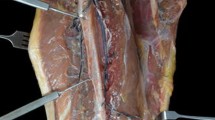Abstract
Background
The most common site of rupture of the posterior tibial tendon is the retromalleolar region where the tendon changes its direction of pull. The aim of this study was to characterize the tissue of the gliding zone of the tibialis posterior tendon to gain further knowledge about possible structural causes for spontaneous tendon rupture.
Methods
Light microscopy, transmission electron microscopy and immunohistochemical methods were used to describe the structure of the human tibialis posterior tendon.
Results
In the region where the tendon wraps around the medial malleolus, the structure of the tissue changes from the typical structure of a traction tendon. The superficial zone which was directed towards the pulley tissue had the structure of fibrocartilage with a specific three-dimensional collagen fibril texture. Transmission electron microscopy showed chondrocytes with a felt-like pericellular matrix that increased in size towards the gliding surface. The extracellular matrix of the fibrocartilage was rich in acid glycosaminoglycans and stained intensively with alcian blue at pH 1. Immunohistochemical staining of cartilage-specific extracellular matrix components such as type II collagen, chondroitin-4-sulphate, chondroitin-6-sulphate, keratan sulphate and aggrecan was positive.
Conclusion
The location of the fibrocartilage corresponds to the region where the tibialis posterior tendon wraps around the medial malleolus, which serves as a pulley. According to the theory of 'causal histogenesis', the stimulus for the development of fibrocartilage within dense connective tissue is intermittent compressive and shear stress. The fibrocartilaginous region is the region where most spontaneous ruptures of the tibialis posterior tendon occur. Due to its structure, the fibrocartilaginous region may be more vulnerable to repetitive tensile microtrauma; degeneration may occur due to the poor repair response of the avascular fibrocartilaginous tissue.





Similar content being viewed by others
References
Altmann K (1964) Zur kausalen Histiogenese des Knorpels. W. Roux`s Theorie und experimentelle Wirklichkeit. Z Anat Entwicklungsgesch 37:1–167
Benjamin M, Evans EJ (1990) Fibrocartilage. J Anat 171:1–15
Benjamin M, Quin S, Ralphs JR (1995) Fibrocartilage associated with human tendons and their pulleys. J Anat 187:625–633
Caterson B, Calabo T, Donohue PJ, Jahnke MR (1986) Monoclonal antibodies against cartilage proteoglycan and link protein. In: Kuettner K (ed) Articular cartilage biochemistry. Raven Press, New York, pp 59–73
Frey C, Shereff M, Greenidgen N (1990) Vascularity of the posterior tibial tendon. J Bone Joint Surg Am 72:884–888
Gillard GC, Rilley HC, Bell-Booth PG, Flint MH (1979) The influence of mechanical forces on the glycosaminoglycan content of the rabbit extensor flexor digitorum longus tendon. Connect Tissue Res 7:37–42
Giore NJ, Beaupré GS, Carter DR (1993) Cellular shape and pressure may mediate mechanical control of tissue composition in tendons. J Orthop Res 11:581–591
Hintermann B (1995) Die Dysfunktion des M. tibialis posterior infolge Sehneninsuffizienz. Orthopaede 24:193–199
Janis LR, Wagner JT, Kravitz RD, Greenberg JJ (1993) Posterior tibial tendon rupture: classification, modified surgical repair, and retrospective study. J Foot Ankle Surg 32:2–13
Johnson KA, Strom DE (1989) Tibialis posterior dysfunction. Clin Orthop 239:196–206
Josza L, Kannus P (1998) Human tendons. Human Kinetics, London
Kannus P, Josza L (1991) Histopathological changes preceding spontaneous rupture of a tendon. A controlled study in 891 patients. J Bone Joint Surg Am 73:1507–1525
Koch S, Tillmann B (1995) The distal tendon of biceps brachii. Ann Anat 177:467–474
Leadbetter WB (1992) Cell-matrix response in tendon injury. Clin Sports Med 11:533–542
Mann RA, Thompson FM (1985) Rupture of the posterior tibial tendon causing flat foot. J Bone Joint Surg Am 67:556–561
Milz S, Mc Neilly C, Putz R, Ralphs JR, Benjamin M (1998) Fibrocartilage in the extensor tendons of the interphalangeal joints of human toes. Anat Rec 252:264–270
Moiser SM, Pomeroy G, Manoli A (1999) Pathoanatomy and etiology of posterior tibial tendon dysfunction. Clin Orthop 365:12–22
Pauwels F (1960) Eine neue Theorie über den Einfluß mechanischer Reize auf die Differenzierung der Stützgewebe. Zehnter Beitrag zur funktionellen Anatomie und kausalen Morphologie des Stützapparates. Z Anat Entwicklunggesch 121:478–515
Petersen W, Hohmann G, Stein V, Tillmann B (2001) Blood supply of the posterior tibial tendon—a quantitative study in human cadavers. J Bone Joint Surg Br 84:141–144
Ploetz E (1938) Funktioneller Bau und funktionelle Anpassung der Gleitsehnen. Z Orthop 67:212–234
Refior HJ, Kroedel A, Melzer C (1987) Examinations of the pathology of the rotator cuff. Arch Orthop Trauma Surg 106:301–306
Uthoff HK, Sarkar K (1991) Pathology of rotator cuff tendons. In: Watson (ed) Surgery disorders of the shoulder. Churchill Livingstone, New York
Vogel KG, Ördög A, Pogány G, Oláh J (1993) Proteoglycans in the compressed region of human tibialis posterior tendon and in ligaments. J Orthop Res 11:68–77
Acknowledgements
We want to thank Mrs. R Worm, Mrs. K. Stengel, Mrs. S. Seiters, Mrs. H. Siebke and Mrs. H. Waluk, members of the Department of Anatomy of the Christian Albrechts University Kiel, for their expert technical assistance. The work was supported by a grant from the 'Forschungsschwerpunkt Muskel und Skelettsystem' of CAU Kiel. The monoclonal aggrecan antibody developed by B. Caterson was obtained from the Developmental Studies Hybridoma Bank developed under the auspices of the NICHD and maintained by the University of Iowa, Department of Biological Sciences, Iowa City, IA 52242, USA.
Author information
Authors and Affiliations
Corresponding author
Rights and permissions
About this article
Cite this article
Petersen, W., Hohmann, G., Pufe, T. et al. Structure of the human tibialis posterior tendon. Arch Orthop Trauma Surg 124, 237–242 (2004). https://doi.org/10.1007/s00402-003-0500-5
Received:
Published:
Issue Date:
DOI: https://doi.org/10.1007/s00402-003-0500-5




